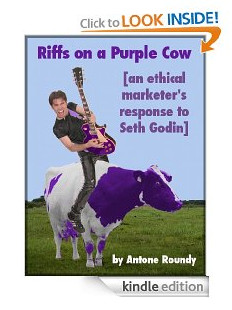When you purchase through links on our site, we may earn an affiliate commission (details)
Selling to Cold, Cool, Warm & Hot Traffic, Part 2
About a week ago, I posted some thoughts about how to sell differently to hot vs. cold traffic (and everything in between). If you haven't read that post, I recommend reading it now, because I won't be repeating some important points I wrote about there. At the end of that post, I promised to finish the thought, so here it is.
Selling to hot traffic
Hot traffic already has a pretty good handle on what problem they're trying to solve, what kind of product will solve it, and how it'll do it. They just need to decide whether your product is the best choice.
So how do you talk to them? A 50 page sales letter that tells them what their problem is, how to solve it, and reveals that you've got a product that implements the solution? What a waste of time!
What they want to know is:
- What features does your product have? (so they can compare to other potential solutions)
- What are the technical requirements? (will it run on their computer or webserver, etc.)
- How much does it cost?
- What's are the terms of your guarantee?
- Does anybody else use and like it? (social proof)
- What bonuses do they get with it?
That's the information they want. Don't dilute a page that you know is getting hit by hot traffic with details that they don't need.
How do you know whether a page is getting hot traffic or not?
Before I continue, let's address that question. The way you know what kind of traffic a page is getting is that you use different techniques to drive different kinds of traffic to each page. For example, unless you're advertising on highly targeted hot buyer keywords, you don't send PPC traffic to your hot traffic sales page.
One way to segment traffic is to give your affiliates links to each sales page, and tell them what kind of traffic to send to each.
If they've got customers who they've prepared to buy your type of product (for example, if your product will enhance their product, and they've told their customers all about why they need it), have them use the link to the hot traffic sales page. If they're adding a promo for your product to a loosely related affiliate autoresponder sequence, have them use the cool traffic link.
Selling to warm traffic
Warm traffic knows what their problem is and has a pretty good idea of the end result they're after, but they don't know how to get there yet. They need you to show them how your product can solve their problem. Compared to hot traffic, you'll want to focus more on benefits and less on specific features.
Like hot traffic, your sales letter can be fairly direct -- you don't want to bore them to death introducing the problem and making it sound as bad as possible. But you do need to prove that you understand the problem clearly, or they may not believe that your solution will really work for their problem.
Selling to cool traffic
Cool traffic has an itch, whether it's a problem they're aware of but not committed to solving yet, or just general interest in your product category. Since they're not in buying mode yet, your marketing methods need to focus on getting them there -- which won't necessarily happen all at once.
You'll want to get them on a mailing list if at all possible, since that will enable you to follow up repeatedly.
Whether in your autoresponder messages or on your cool traffic sales pages, you'll want to educate them about the problems they have (and the fact that you understand them clearly), what they're missing out on by not solving them ("gap analysis"), the fact that there is a solution and all of its benefits (if the solution is quick, easy and/or cheap, emphasize that), etc. They probably don't need to see an exhaustive feature list, but lots of benefit bullets can be powerful persuaders.
Until you're certain that the follow up emails you're sending are converting them to hot prospects, you'll want to link from your emails to sales letters designed for luke-warm prospects, or to other webpages designed to assist you in warming them up further. For example, you might send them to a survey or other interactive webpage designed to increase their interaction with you.
Selling to cold traffic
Your product isn't even a twinkle in cold traffic's eye, so the last thing you want to do is push them away with a hard sell approach. You may be able to get them to join your mailing list, but your primary goal is simply to catch their interest and get them engaged with you in some way you that you can get them thinking about things related to your product.
Since cold traffic isn't looking for you, it's hard to target. But you can leave things lying around for them to trip over: blog posts (also good for warmer traffic, particularly if you can pull them into a conversion in the comments), videos on YouTube and other video sharing sites, short surveys that might catch their eye, etc.
Sales letters for cool and cold traffic in particular need stories to engage them. They may not be interested in your product yet, but they might be interested in reading about people, their problems, and how they solved them.
Selling to secondary targets
A sales letter targeted at warm traffic will invariably be seen by some cold, cool and hot prospects. You don't want to dilute your primary message by adding things for them. But there are other ways to target them. For example, you could use an exit hover ad to present a message targeted at traffic that's cooler than your sales letter is designed for.
Present them with a smaller commitment or easier interaction than you're asking for from your primary target, and use it to warm them further and get them onto your mailing list.
A few final notes
Here's a natural sequence for you to guide prospects through. Not everyone will need to go through every step, nor will every product need each step. But take a moment to consider how you might do each, and whether adding more of these might help you convert more prospects into repeat customers:
- Notice you
- Read
- Respond (survey, blog comment...)
- Subscribe (autoresponder, RSS)
- Download (your special report or whatever)
- Read or use what they downloaded (be sure to follow up with them and remind them, teach them how, tell them why they should do it now, etc.)
- Buy
- Recommend you to their friends, subscribers, etc.
- Buy more/again
To prepare your buyers for the last two steps, follow up and make sure they use your product, and use it successfully.
Let me know what you think about these posts, and if you found them interesting, use the buttons below to share them with your friends.





July 26th, 2010 at 6:35 pm
Antone, Thank you for the useful information,I'm 56yrs. old and have only been on a computer,and online for a little over two years,with only self taught knowledge.I find your blog very informative.I do how ever tend to disagree with what I see as a industry wide habit of overloading the buyer with "bonuses",as information overload is a real problem for some of us.A offer of "bonuses" at a later date (rain check) would seem to me to be a lot better received by the"average" buyer.I know that I'm still learning every day about the auto responder,it's uses in marketing,and the different marketing tips I can use and give to others.If I added a big list of Free Bonuses,I would just overwhelm someone of my caliber.
July 26th, 2010 at 7:33 pm
Paul,
Thanks for the comment. I agree that often, the never-ending list of bonuses attached to a product gets pretty absurd -- especially when the bonuses aren't directly related to the main product. If the bonuses are things that will enhance the value of the main product, that's ideal and doesn't muddy the offer. But if looks like the seller just wanted to tack on some bonuses, so they threw in a bunch of random junk, then I think you're exactly right.